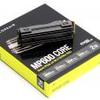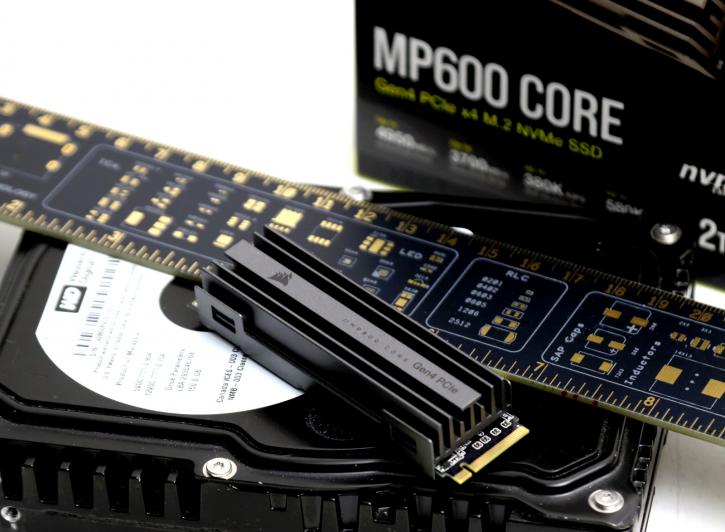Final Words & Conclusion
Final Words & Conclusion
Other than it carries the stigmata QLC, we do like the MP600 CORE series. Yes, we need to talk about that for a bit. QLC combined in the right circumstances does not displease in performance. Read performance is excellent (which is what you'll be doing 90% of the time); writes are a notch slower than the TLC counterparts with the same 5016 E16 Phison controllers. The differences are not something you'll notice in real-world performance. Granted, though, write performance takes dip downwards a bit, but if 2 to 3 GB/sec writes bother you, then there's little left for me to convince you. QLC write holes are pretty non-existent thanks to pSLC and DRAM buffers, so that's not a relevant argument any longer. Our workload tests show the pSLC and DRAM buffers to be well balanced. Two things remain a topic of discussion then; pricing and endurance. For an SSD at this performance level, you can argue that 16 cents per GB are pretty okay. Hey, we all wish it was at 10 cents per GB, but in this premium perf segment, that's still a few years away. So that leaves the elephant in the room, endurance, and we'll dedicate a full chapter on that.
Endurance
We explained it many times already, endurance, the number of times NAND cells can be written before they break down. For QLC written (4 bits stored in a single NAND cell), it suffices to say; the values are not very good. However, I always love to quote Einstein on this one; relativity, my man. You can remedy endurance with relatively bigger volume sizes. 98% of your data sits in a 'cold' state on your SSD and does nothing, and it's the 2% that gets written that counts. Bigger volume sizes mean more NAND cells; more NAND cells increase endurance. For the 4TB model, you'll get 800 TBW, the 2 TB model marks 400 TB written, and the 1 TB model gets merely 200 TBW. Yup, that's the reason why you will not see smaller models released, as, at 500GB, you'd be looking at 100TBW. For a laptop that feasibly works, for a PC or workstation, just no. Our tested 2 TB SSD thus gets 400 TBW. Now when a NAND cell dies, that doesn't mean your data is lost. Your data is monitored and managed by many algorithms; the bits inside one cell will be moved to a healthy one if that cell's lifetime soon would be depleted.
This 2TB QLC based SSD could last you 20+ years.
How long does a 400 TWB storage unit last before NAND flash cells go the way of the dodo? Well, if you are a really extreme user, you might be writing 50 GB per day (really normal users probably won't even write that per week), but based on that value, 50GB x 365days= 18.25 TB per year written. You get 400 TBW, so that's 21.9 years of usage and half that for the 1TB SSD. Let me make it very clear, 50 GB per day is a very ambitious number. So we feel that QLC has merit, as long as you purchase high volume sizes, plain and simple.
Performance
You cannot deny that the MP600 CORE is a speedy product. Of course, the design basics are based on templates we have seen before and recognize. The price is okay, performance grand, up-to at least the tested 110GB continuous writing. You'll be hard-pressed to find a QLC write hole. Strictly speaking, from noting down the highest values, this was among the faster NVMe SSDs we have ever tested. But if you look at it relatively towards other SSDs, it's simply put a high-end class performing QLC M.2 SSD. Trace tests showed the performance to be slightly worse though, that has everything to do with QLC. We're talking split-second differentials, though. Overall throughput in read performance goes 3.4 even 5 GB/sec. Writes, however, a little dimmer compared to TLC NAND. But we're still at a 2 GB/sec marker for linear and sustained write performance. At 16 cents per GB, I cannot complain about that. The trace tests you have seen from the PCMark 8 suite fully load and stress up the SSD, and it is here where the CORE was a bit average, but only here. However, we deem the PCMark 8 trace tests to be among the best benchmark series in our test suite. We also need to place it all in a relative matter; this SSD does reach 5 GB/sec given the right workload and titles like Crystaldiskmark and ATTO. Copying many, many gigabytes of movies and ISOs, for example, well, this SSD laughs at it, and while copying I actually laughed a bit nervously. I mean our 110 GB test file I had to copy towards this SSD from a Gigabit NAS, which took 18 minutes. Then copying the same file from a product of this caliber for less than a minute with 2 GB/sec writes.
Concluding
Relativity, I mentioned the word already. We do not endorse QLC if an SSD is based on small volume capacity, say 250 or 500 GB. Here endurance becomes an issue. However, starting at 1 TB volume sizes, QLC will make more sense (if priced right). And it's exactly that what Corsair is doing with the MP600 CORE series. They skipped a 250 and 500 GB version just for the sole reason of endurance. At 1 TB you get 200 TBW, the 2 TB unit gets 400 TBW, and the 4 TB gets 800 TBW. You can argue that the 1 TB model at 200 TBW is still icky, but even there at 50 GB writes per day, you're still be passing ten years of lifespan. That's said, to put your and my mind at ease, I would opt for 2TB as a minimum. The MP600 CORE series did not run into write holes; the product has sufficiently been buffered by a pseudo-SLC write cache and 1 GB of DRAM buffer. So that's not a reason to dislike this product. Paired with the heatsink, the controller status under 50 Degrees C also. Of course, to get the best out of it, you'll need a PCIe Gen 4 infrastructure, and at the time of writing, that means a compatible Ryzen processor on, say, a B550 or X570 chipset-based platform. Later in 2021, Intel will start with PCIe gen 4.0 as well. The unit shivers in performance given the right conditions, and for the rest of them, on some workloads, you are down to high-end class NVMe performance. Corsair backs the storage unit with a proper five years, that or the TBW value reached. Whichever one comes first. And there you have it; at 16 cents per GB, Corsair does offer a compelling product series. It's plenty powerful for any workload, really. With my advice at hand, I hope you can make a more informed purchasing decision, and I hope I have taken away some of your doubts about QLC endurance. The bigger that SSD volume size is, the safer you'll be. We recommend the 2TB model or the 1 TB version for just that reasoning, but we also understand that QLC SSDs will be a hard sell fighting that endurance stigma. We can't wait to get our hands on the new 7 GB/sec models also. We hope to bring you a review soon.
Recommended Downloads



